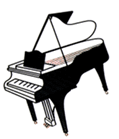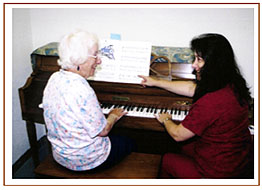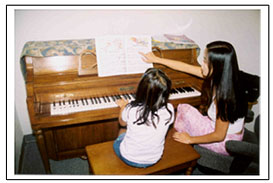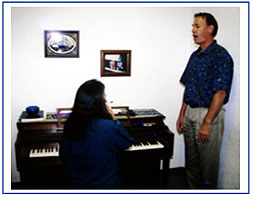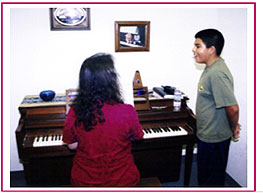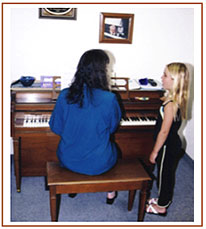| LESSONS |
Joyful
Keys Music Studio |
Who We
Teach
All ages - from children to senior citizens.
All levels - from beginning to advanced.
When We Teach
The studio is open Monday through Friday, and typically on Saturdays. The
studio is closed on Sundays and major holidays. We offer morning, afternoon
and evening lessons. Please call the studio regarding your specific
scheduling needs.
How We
Teach
Each student is an individual. What may be good for one may not work for
another. We go at a pace that is comfortable and appropriate for each
student—based on age, ability, desire and goals. Are you learning music for
enjoyment and growth? Are you interested in performing? Are you preparing
for college? Or, are you planning a career in music? We will tailor your
program to your specific needs.
We teach the mechanics with
universally recognized techniques and method books. Typically, this
includes learning how to read music, which enables you to advance to higher
levels of understanding and performance. Do you have to learn how to read
music? You don’t have to, but we recommend it.
Most of all, we try to make
it enjoyable. Learning music is an enriching experience—one that has the
capacity to enhance your enjoyment of music and quality of life.
What We Teach
Piano, guitar and voice. (With interest, we can include other
instruments). Explained separately in the last button below, we incorporate
elements of music theory (principles of music) into our piano, voice and
guitar lessons. Please click on the blue button below for your topic of
interest.
Piano
An acoustic piano is non-amplified. Sound is produced when the strings are
struck by hammers. An electronic piano uses electronic pulses to generate
an oscillating signal. It is programmed to replicate the sound of an
acoustic piano. A synthesizer is an electronic piano that has been
programmed to replicate (synthesize) the sounds of the piano and other
instruments, such as percussion, horns, strings and woodwinds.
The piano produces the
fullest and most complete harmonic sound of all the musical instruments, and
is the most widely used instrument for vocal accompaniment. Because of its
versatility, most composers and songwriters compose at the piano. Even
those who use a computer for composing create the sounds on an electronic
keyboard.
Because there is a physical
key to identify with each note, the piano is an excellent instrument for
learning the principals of music. Once you know how to play the piano and
understand basic music concepts, other instruments are generally easier to
learn. At Joyful Keys, our instruction on the piano involves the
following:
A variety of instruments
led to the development of the piano. The earliest known keyboard instrument
was a water organ that used sliders to control air (compressed by water)
through pipes (around 3rd century B.C.E.). Development of a
stringed instrument using a keyboard is thought to have appeared around the
10th century—the hurdy-gurdy. It was somewhat of an outgrowth of
the violin, using a wheel rotated against strings to sound notes.
By the late 1300s,
keyboard instruments had mechanisms to strike the strings to make sound. In
the clavichord, the keyboard actuated metal wedges to strike the strings—the
basic principle of modern pianos. By the 1600s, the harpsichord was more
popular due to its louder sound, though its strings were plucked rather than
struck.
The harpsichord was
replaced by the pianoforte, which is what we know as the piano today.
Invented in the 1690s, the pianoforte used keyboard-actuated hammers that
struck the strings. By 1735, the first upright piano was made, and by 1844,
the eight-octave grand piano was produced.
References:
Cooper, Paul. Perspectives in Music Theory (Dodd, Mead & Co., 1974).
Crombie, David. Piano—Evolution, Design & Performance (Barnes &
Noble, 2000).
Grout, Donald. A History of Western Music (W.W. Norton & Co., 1973).
Website:
http://elwood.pionet.net/~hub7/
- Numerous articles and references.
BACK TO TOP
Guitar
With stringed boards as predecessors, early guitars were formed by fixing
strings over various natural shells as sound boxes—turtle shells, fruit
shells and others. The guitar most likely evolved from the lute, a plucked
string instrument. In the 1400s, the guitar came into prominence as an
eight-stringed instrument with four double courses that could be
rhythmically strummed. A larger five-course guitar was created in Italy
during the 1600s. As a result, the guitar grew in popularity throughout
Europe, and a variety of solo and ensemble music was composed for it.
In the mid 1800s, the
guitar’s design was improved by adding doubled strings, metal tuning screws,
and enlarging the sound box, thus creating the forerunner of the modern
classical guitar. In the 20th century, Andres Segovia helped
popularize the guitar by transcribing many works written for the lute and
harpsichord. He influenced composers to write new music for the guitar and
music schools to establish courses in classical guitar.
Today, there are two
varieties of acoustic (non-amplified) guitars—the traditional six-string and
the classical twelve-string. In 1931, a commercially viable electric guitar
was invented by George Beauchamp. Popularized by Leo Fender in the early
1950s, today the electric guitar is the lead instrument for most pop music
bands. Though not easy for advanced play, the guitar is considered one of
the easier instruments for a beginner’s introduction to music.
At Joyful Keys Music
Studio, we teach:
-
Playing position
-
Guitar tuning
-
Learning notes on the
fret board
-
Right and left hand
techniques
-
Reading music (notes
and tablature)
-
Scales and chords
-
Theory
-
Improvisation
-
Playing
styles—classical, rock, popular, jazz and others
|
 |
|
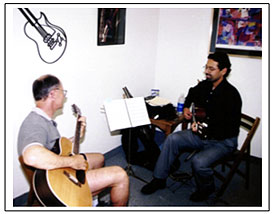
|
|
References:
Cooper, Paul. Perspectives in Music Theory (Dodd, Mead & Co., 1974).
Crombie, David. Piano—Evolution, Design & Performance (Barnes &
Noble, 2000).
Grout, Donald. A History of Western Music (W.W. Norton & Co., 1973).
Krieger, Diane. “The Astonishing LAGQ,” USC Trojan Family Magazine,
Vol.34 #2 (Univ. So. Calif. Summer 2002)
Schmid, Will. Guitar Method (Hal Leonard Corp., 1994).
Web site: Smithsonian
National Museum of American History (www.si.edu/lemelson/guitars).
Website:
http://elwood.pionet.net/~hub7/
- Numerous articles and references.
BACK TO TOP
Voice
The vocal process is a method of producing sound that involves use of the
jaw, mouth, tongue, throat, vocal chords, lungs and diaphragm. In order to
sing, these components are used. To sing properly, these components must be
well coordinated.
At Joyful Keys Music
Studio, our teaching methods employ the correct techniques to enable you to
produce the best sounds possible. Great singers are highly acclaimed not
just for their natural talents, but for their excellent technique as well.
Proper vocal technique will
not only help you become a better vocalist, but it will help you learn to
harmonize, balance and blend with other singers as well. At Joyful Keys, we
are experienced at training soloists and group singers. Periodically, such
as during summer sessions, we form choral groups at the studio.
At Joyful Keys, we teach:
References:
Cooper, Paul. Perspectives in Music Theory (Dodd, Mead & Co., 1974).
Schmidt, Jan. Basics of Singing (Schirmer Books, 1998).
BACK TO TOP
Music Theory
Music theory is not
a mandatory part of our lessons, but it is extremely advantageous. Whether
you are interested in learning how to sing or to play an instrument, we
believe in teaching not just the mechanics of playing or singing but,
simultaneously, incorporating principles of music. This lays the proper
foundation for learning, developing good habits and advancing. Music is
another language—to understand it and play it properly, you should be able
to read it. Knowledge of music theory enables you to use the appropriate
interpretation to achieve the desired effect of each musical composition.
Any instructor can teach
you to sing a song or sound notes on an instrument. Music theory gives you
a broader understanding of the principles of music. With it, you develop
the skills to perform music through interpretation rather than through
memorization. Theory also helps you with improvisation and advancement
beyond the mechanics of playing known compositions.
Depending on the
instrument and the student’s level of skill and experience, we incorporate
the following principles to varying degrees:
-
Elements of music:
rhythm, melody,
harmony, color, texture
-
Musical notation
-
Sight reading
-
Intervals—comprehension and application
-
Chord structure
-
Scales and modes
-
Interpretation of form
-
Analysis of
compositions
|
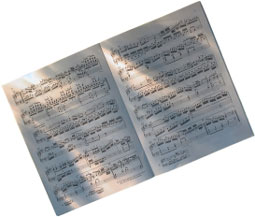 |
|
At Joyful Keys Music Studio, our objective is for you to enjoy the process of
learning music and to help you achieve your musical goals and
dreams.
References:
Cooper, Paul. Perspectives in Music Theory (Dodd, Mead & Co., 1974).
BACK TO TOP
|
|
